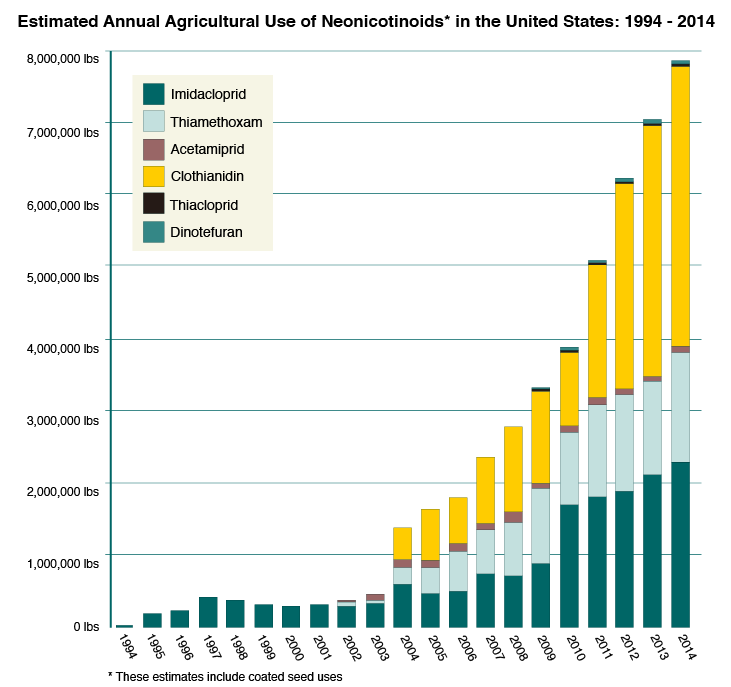The most comprehensive and peer-reviewed studies to date on neonicotinoid pesticides (neonics) confirm their harm to both honeybee and wild bee populations around the world. Honeybees experience a 24% decline in colony size the winter after exposure and wild bees demonstrate lower reproductive rates. What’s even more concerning is that beehives are easily contaminated with these synthetic pesticides through soil dissemination, regardless of geographic proximity. With an estimated three quarters of global crop species, ranging from apples to almonds, relying on pollination by bees and other beneficial animals, we must end our reliance on dangerous agrochemicals and opt for crop care solutions that pose no risk to the environment.
The Centre for Ecology and Hydrology (CEH) at the Natural Environment Research Council studied bee activity in field research that spanned 2,000 hectares across the United Kingdom, Germany and Hungary. Researchers planted oilseed rape (canola) and treated each plot with typical field-level amounts of synthetic pesticides. Each plot was sprayed with either clothianidin, a neonic produced by Bayer, thiamethoxam, a neonic produced by Syngenta, or else left untreated to serve as the study’s control. Honeybee colonies, as well as two other wild bee colonies (bumblebees and red mason bees), were then introduced in the surrounding areas. After the flowering season, the scientists examined the nests to analyze bee behavior, chemical levels and population rates. At most sites — specifically in the United Kingdom and Hungary — bees feeding on neonic-treated canola fields generally fared worse than bees that lived around untreated canola. When exposed to neonics, wild bees and honeybees had more difficulty reproducing, and fewer honeybee colonies survived the winter. The results in Germany were markedly different, with honeybee colonies prospering regardless of whether or not they lived near canola fields treated with neonics. Even so, fewer colonies were found to survive the following winter. Essentially, this proves that neonics hinder the survival rate and establishment of new colonies in the years following exposure.
Source: Pollinator Stewardship Council
.Despite funding the multi-million dollar study, Bayer and Syngenta “do not share CEH’s interpretation [of the results] and remain confident that neonicotinoids are safe when used responsibly.”
Several thousand miles away, researchers from York University in Canada examined how chronic exposure to neonics from corn crops affected bees after a two-year period. They not only concluded that bees were negatively affected by neonics exposure from the treated corn crops, but also found traces of other synthetic chemicals in their study. This is a clear indication that neonics cause widespread dissemination and show long-term persistence in the soil from previous growing seasons. While analyzing results, researchers found that traces of neonics were more commonly found with herbicides or fungicides, and that their combination doubled the toxicity in some cases..
Wild Bee Reproductive Success in Response to Neonicotinoid Nest Residues
Source: Science (2017)
.Neonics comprised a quarter of the $60 billion pesticide market in 2016. With Walmart, Lowe’s, Home Depot, Aldi and Scotts Miracle Gro all phasing out the sale of this synthetic pesticide, and the European Union considering its widespread ban, safe and sustainable alternatives are well positioned to take over significant market share.
Bees are essential for survival. Without them, many plants – including agricultural crops – would die, substantially reducing the world’s food supply. We must therefore shift our mindset and use natural, organic alternatives, like neem-based crop care solutions, which pose no risk to the bee population. Even though neem is a strong, effective and natural pesticide, it is one of the few available that are non-toxic for beneficial insects such as bees. Since neem is active only on leaf-eating pests, bees remain unaffected, and neem can even be used to treat hives for mites when sprayed at low concentrations. Bees are also attracted to the sweet smelling neem flowers, extracting the nectar and converting it, along with all of neem’s impressive and diverse properties, into a delicious honey that has added health benefits.
A dark honey typically produced by wild bees, neem honey is truly pesticide-free. When raw and unheated, neem honey contains the beneficial enzymes and antioxidants that are found in the neem flower. Carrying neem’s anti-inflammatory, antibacterial and antiseptic properties, the honey is used to treat diabetes, skin problems, allergies and infections.
Beehives on-site at Primal Group’s plantations in Ceará, Brazil
.With an end goal of 100 beehives on-site at their plantations in Ceará, Brazil, Primal Group have implemented 35 hives to date. Each hive has a capacity of up to 70,000 bees, however this number will vary depending on the season. Vital to the environment, these bees will increase pollination while demonstrating the viability of neem as a natural pesticide and fertilizer that functions in harmony with bees. Partnering with the Federal Institute of Ceará, Primal Group has begun scientific research on the relationship between neem and bees in the field. By conducting this research, neem’s legitimacy as a safe and effective solution in sustainable crop care will increase, especially considering the damaging nature of neonics and the threat they pose to the world’s food supply.


